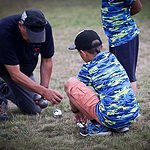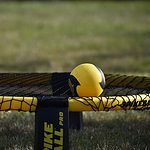Is it truly possible to predict every move your opponent makes in Frisbee? You might find that mastering advanced marking techniques offers the best chance to control the game's pace and limit the opposing thrower's options. By implementing strategies such as force middle or no around marks, you're not just reacting; you're anticipating and preparing for their every potential move. This requires not only physical agility but an acute sense of awareness and communication on the field. Consider how these strategies could shift your approach, and perhaps transform your team's defensive dynamics, prompting a significant question: How well can you really anticipate an opponent's play?
Understanding Marking Basics

Why is marking an essential skill in Ultimate Frisbee? Marking effectively limits the thrower's options, disrupting the flow of the offense and increasing the chance of turnovers. As you engage in marking, staying within three meters of the thrower is vital. This proximity pressures the thrower and narrows their field of vision and available angles.
To elevate your marking skills, focus on these training tips: First, develop your positioning. Anticipate the thrower's likely moves and position yourself to counteract them. React quickly to their movements while maintaining legal distance to avoid fouls. Next, refine your footwork. Agile and balanced foot movements are crucial for effective marking. Practice lateral and quick-step drills to enhance your agility and ability to stay in front of the thrower without crossing into their personal space.
Lastly, communication is key. Always coordinate with your teammates on-field to understand their positions and the overall defensive strategy. This awareness allows you to adjust your marking strategy dynamically, depending on the game situation. By mastering these basics, you'll become a formidable marker, greatly bolstering your team's defensive capabilities.
The Fundamentals of Force Middle
To excel in the Force Middle strategy, you'll need to master effective positioning. This involves aligning yourself centrally, anticipating the disc carrier's movements, and cutting off their preferred throwing lanes.
Coordination with teammates is essential; make sure you're communicating constantly to maintain pressure and adapt to the flow of the game.
Establishing Effective Positioning
Understanding Force Middle strategy in ultimate frisbee begins with mastering how to position yourself as a defender to control the game's pace and limit the offense's options. You need to be adept at anticipating player movements and making quick decisions to effectively implement this strategy.
Here are key positioning tips:
- Stay Centered: Position yourself centrally between the disc and the intended receiving area to cover maximum ground.
- Anticipate Passes: Read the handler's eyes and body to predict and intercept potential passes.
- Limit Options: Consciously steer the handler towards less favorable throwing lanes by subtle shifts in your stance.
- React Quickly: Be ready to adjust your position dynamically as the disc and players move.
Communication and Coordination
In Force Middle defense, effective communication and precise coordination among teammates are essential to successfully restrict the offensive team's options and control the flow of the game. You'll need to constantly adjust your positioning based on the movements of the disc and the offensive players. Here's how you can optimize your coordination and communication:
| Action | Purpose |
|---|---|
| Strong Mark | Limits the thrower's options and angles. |
| Vocal Alerts | Informs teammates of disc movement. |
| Quick Shifts | Responds to offensive plays dynamically. |
| Poach Help | Supports teammates in intercepting passes. |
Strategies for Force Sideline

Mastering Force Sideline requires you to strategically position yourself, compelling the offensive player towards the sideline to effectively narrow their playing options. This limits their vision and available space, increasing the likelihood of turnovers.
Here's how you can optimize your Force Sideline strategy:
- Positioning: Stand slightly off-center towards the sideline side of the offensive player. This angle limits their forward and inward field options, funneling play towards the sideline.
- Footwork: Maintain agile footwork. You'll need to react quickly to the offensive player's movements while continually guiding them sideline. Your stance should be balanced but ready to move.
- Communication: Constantly communicate with your teammates. They should know your intention to force sideline so they can adjust their positions accordingly, creating a cohesive defensive effort.
- Anticipation: Learn to anticipate the offensive player's moves. By understanding common plays and player tendencies, you can predict and counter their actions more effectively.
The Role of Flat Marking
While Force Sideline focuses on narrowing play, flat marking positions you to block critical passing lanes, disrupting the offensive flow effectively. In this approach, you're not just shadowing the thrower; you're strategically placing yourself to create a barrier between potential passing targets. This method hinges on your ability to read the game and anticipate the thrower's intentions, a skill that demands both agility and mental acuity.
As you adopt a flat marking stance, your primary goal is to limit the thrower's options. By positioning yourself equidistant from multiple receivers, you force the thrower into a tight spot. The pressure mounts as their usual outlets close off, increasing the likelihood of a forced error or a turnover. It's essential that your movements remain fluid and reactive. As the thrower pivots or the disc's intended path shifts, you'll need to adjust swiftly to maintain coverage over the most threatening lanes.
Implementing No Around Marks

To effectively implement no around marks, you must first establish your position strategically between the handler and their intended passing lanes.
You'll need to predict and react quickly to the handler's movements, ensuring that you're blocking all easy pass options.
This method forces the offense to explore riskier throwing alternatives, potentially leading to turnovers and increased defensive success.
Establishing Position Effectively
Implementing 'no around marks' effectively restricts the offensive players' options, compelling them to confront direct defensive challenges. As you adopt this strategy, your primary goal is to limit the easy throwing paths, pushing the offensive player into less favorable positions. This requires not only individual skill but also a synchronized team effort.
- Positioning: Maintain a stance that blocks the common around throws.
- Anticipation: Predict the offensive player's moves to stay one step ahead.
- Communication: Constantly communicate with teammates to make sure coverage and adjust as needed.
- Discipline: Stay focused on your role without getting drawn away, ensuring the mark is consistently tight.
Force Options Exploration
Exploring force options in ultimate Frisbee, such as the 'no around marks' strategy, allows you to strategically limit offensive plays by cutting off common passing lanes. By implementing this technique, you're focusing on preventing throws to the break side. This forces the offense to contemplate more centrally directed or riskier options, potentially leading to turnovers.
You'll need to position yourself to effectively block around throws, maintaining a stance that prioritizes agility and anticipation. Practicing this mark requires you to understand the typical flow of the game and anticipate the thrower's movements.
Mastery of 'no around marks' can disrupt the offensive rhythm and increase your team's chances of regaining possession.
No Break Marking Explained
No break marking strategically positions you to obstruct the thrower's access to the break side, thereby limiting their passing options. This approach is central in frisbee defense, as it forces the thrower into less ideal throws, increasing the likelihood of a turnover.
Here's how you can effectively implement no break marking:
- Positioning: Stand slightly off-center towards the break side, keeping your feet agile and ready to move. This placement cuts off the easy pass lanes to the break side.
- Anticipation: Develop an ability to predict the thrower's moves. This requires you to understand their tendencies and the overall game situation. React swiftly to any shifts by the thrower to maintain coverage.
- Communication: Constantly communicate with your teammates. Let them know where you're forcing the thrower so they can adjust their positions and close potential open lanes, creating a unified defensive front.
- Field Awareness: Keep track of other players' locations, both offensive and defensive. This awareness helps you anticipate possible passing options and adjust your marking strategy accordingly.
Techniques of Straight-Up Marking

To effectively utilize straight-up marking, position yourself directly in front of the thrower, aiming to obstruct multiple throwing lanes and challenge their decision-making process. You'll need to maintain a balanced stance with your feet shoulder-width apart, which allows for quick lateral movements. Keep your arms slightly raised and outwards to cover more space, thereby limiting the thrower's easy options.
When applying this technique, it's important to stay on your toes, ready to react. You must anticipate the thrower's movements, watching their eyes and shoulders to predict the direction of the throw. This proactive positioning not only pressures the thrower but also increases the likelihood of forcing a mistake or a less effective throw.
Remember, the goal of straight-up marking isn't just to block one lane; it's to make all potential throws more difficult. By effectively narrowing the thrower's field of vision and reachable angles, you disrupt the overall flow of the offense. This can lead to turnovers, which are crucial in shifting the momentum of the game in your favor.
Stay alert, adapt quickly to the thrower's tactics, and consistently challenge every throw to maximize the effectiveness of your straight-up marking.
Utilizing Poaching Effectively
While straight-up marking focuses on direct confrontation, poaching shifts the strategy to a more anticipative and dynamic defense. As a frisbee player, you'll need to master the timing and spatial awareness required to effectively poach from an opponent. This technique disrupts the flow of the game and can meaningfully alter the offensive strategy of the opposing team.
Here are key aspects to ponder when utilizing poaching:
- Strategic Timing: Develop an intuition for when to leave your mark. Anticipate the thrower's actions and the movement of other players to determine the ideal moment for intervention.
- Risk Assessment: Understand the potential risks. Leaving your mark might open up opportunities for your opponent. Evaluate whether the potential gain of an interception outweighs the risk.
- Team Communication: Constantly communicate with your teammates. Coordination is pivotal to make sure that when you poach, someone else can cover your original mark.
- Anticipation Skills: Enhance your ability to predict plays. Watch game tapes and observe patterns in your opponents' strategies to improve your predictive accuracy.
Transitioning Between Marks

As you focus on shifting between marks, it's crucial to identify marking opportunities where you can most disrupt the opposing team's flow.
Make sure you're switching marks effectively by analyzing the field and understanding when a switch offers a strategic advantage.
Communication during these shifts is key; you must articulate your movements clearly to teammates to maintain a solid defense.
Identifying Marking Opportunities
Identifying marking opportunities requires you to move smoothly between defensive positions, effectively anticipating and disrupting the offensive player's intended passes. To excel, you'll need to:
- Anticipate Movements: Quickly predict where the offensive player is likely to pass, positioning yourself to intercept or obstruct the throw.
- Stay Agile: Maintain flexibility to move swiftly in response to the offensive player's actions, ensuring you're always a threat.
- Communicate Clearly: Constantly talk to your teammates to understand who's marking whom and to cover all potential options.
- Force Turnovers: Position yourself strategically to increase the chances of the offensive player making errors or poor passes.
Mastering these aspects is essential in enhancing your defensive capabilities on the field.
Switching Marks Effectively
Building on your ability to identify marking opportunities, it's equally important to master switching marks effectively to maintain a strong defense. You need to anticipate the opposing team's movements, adjusting your mark swiftly while ensuring your positioning and footwork are precise. This tactical shift not only disrupts their offensive flow but can also lead to critical turnovers.
| Aspect | Importance | Key Action |
|---|---|---|
| Anticipation | High | Predict player movements |
| Communication | Essential | Coordinate without overlap |
| Positioning | Vital | Maintain ideal placement |
| Footwork | Fundamental | Quick, stable adjustments |
Communication During Transition
Why is effective communication important when shifting between marks in advanced Frisbee play? You need to coordinate tightly with your teammates to maintain a strong defense and apply constant pressure. Effective communication guarantees that everyone on the field is aligned, minimizing the chances for the offense to find and exploit gaps.
- Verbal Cues: Clearly call out switches and intentions to teammates.
- Non-verbal Cues: Use hand signals and eye contact to silently communicate changes.
- Anticipation: Be proactive in reading the game and signaling upcoming shifts.
- Quick Decision-Making: Respond swiftly to offensive movements to disrupt their flow and force errors.
Marking in Zone Defense

In zone defense, you focus on guarding designated areas of the field, rather than marking individual opponents. This strategy requires you to constantly adjust your positioning based on the disc's movement and the activity of offensive players within your zone. It's essential that you stay aware of the field's dynamics, ensuring you're effectively covering your area without leaving gaps.
Communication is key in zone defense. You'll need to constantly talk with your teammates, calling out shifts in the offense and coordinating your movements to maintain a strong defensive front. This teamwork prevents the offense from finding easy passes, increasing their likelihood of making risky throws or committing turnovers.
Countering Common Offenses
To counter common offenses in advanced Frisbee play, you'll need to strategically employ force middle defense, poaching, switching techniques, and zone defense. Each of these strategies serves a specific purpose and, when executed correctly, can greatly disrupt the offensive flow of your opponents.
- Force Middle Defense: This technique limits the offensive players' options by funneling them towards the center of the field. By doing so, you're not only reducing the space they've to maneuver, but also increasing the likelihood of interceptable passes.
- Poaching: Here, you temporarily leave your mark to create uncertainty and disruption among the offensive players. This can lead to turnovers if your opponents fail to adjust quickly to the unexpected defensive change.
- Switching Techniques: Effective communication is vital when switching marks. This strategy allows you to adapt quickly to the offense's movements, covering handlers and cutters more efficiently and preventing easy scoring opportunities.
- Zone Defense: Implementing a zone defense clogs passing lanes and compels the opposing team to make challenging throws. It's about creating a defensive net that increases pressure and reduces the offensive team's rhythm.
Utilizing these techniques requires practice and sharp coordination with your team to effectively counteract the common offensive strategies in advanced Frisbee play.
Training Drills for Better Marking

Enhancing your marking skills in advanced Frisbee involves practicing specific drills that focus on agility, hand speed, and reaction times. You'll need to work on footwork drills extensively to improve your agility and positional readiness. These drills should simulate marking scenarios, requiring you to shift directions quickly and stay balanced while shadowing an opponent's movements.
To disrupt throws effectively, you must enhance your hand speed. Exercises like rapid hand tapping and targeted reflex tests can sharpen your ability to block passing lanes and interfere with the disc's trajectory. These activities boost your muscle responsiveness, making your hand movements quicker and more precise during gameplay.
Additionally, honing your reaction times is critical. Drills that involve sudden visual or auditory signals to initiate movement help you adapt swiftly to an opponent's actions. This training ensures you're always ready to counter their next move, preventing easy passes.
Integrate communication drills with your teammates to foster seamless coordination on marking strategies. Practicing verbal cues and non-verbal signals during these exercises promotes better teamwork and understanding on the field.
Conclusion
In wrapping up, remember that effective marking in Frisbee isn't just about agility; it's about smart positioning and teamwork.
Studies show that teams employing advanced marking strategies reduce their opponents' scoring efficiency by up to 40%.
By mastering techniques like force middle and no around marks, and integrating them into your practice drills, you'll not only enhance your defensive acumen but also greatly disrupt the offensive flow of your competitors.
Keep practicing, stay vigilant, and communicate consistently.





